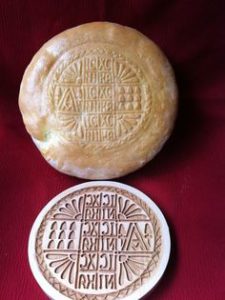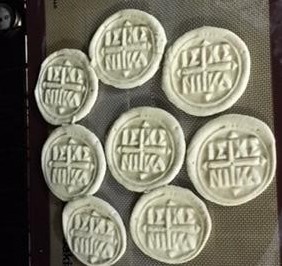 for Western Rite Orthodox Liturgy
for Western Rite Orthodox Liturgy
These instructions are the expanded version taught to us by Subdeacon Jerome Chiles (of Blessed Memory) at St. Gregory the Great Orthodox Church now located in Silver Spring, MD. We have found it more efficient and less distracting to prepare the Prosphora separately from the Antidoron, especially if only one baker is available.
Baking Supplies
- Glass or plastic bowl-e.g. 3qt. Pyrex glass bowl
- Long handled wooden spoon
- 2-cup glass Pyrex measuring cup
- Rolling pin
- 3” round cookie cutter
- measuring spoons
- pastry brush
- 4 – 11” x 16-1/2” silicone baking mats
- cooling racks
- Orthodox bread stamp
- wax paper
- aluminum foil
- paper towels
- heavy bath towel(s)
- thin, rubber exam gloves (e.g. from Costco)
Ingredients
5-pound bag Gold Medal bread flour
table salt
vegetable oil
white sugar
white all-purpose flour
active dry yeast
Pam cooking spray
Instructions:
Pour about two pounds bread flour into glass bowl (this amount will make about 36 hosts); add 1 tsp salt. In a Pyrex glass measuring cup add about 1/2c warm water at 110-115 degrees. Add 1 rounded Tbsp Active Dry Yeast and 1 tsp sugar. Wait for it to bubble (“proof”)—if your yeast was refrigerated, this could take 7-8 minutes.
When liquid has proofed, add it to bowl containing the flour and salt. Stir with long handled wooden spoon—no metal please. Then continue to add warm water gradually to mixture to form it into a large ball. I usually wear a pair of thin, rubber exam gloves to incorporate all ingredients well; total amount of water will vary – may use about a cup or more. After ball is formed, cover with a large piece of wax paper that’s been sprayed with ‘Pam’; put that side down on top of dough; cover with folded bath towel, put in a warm place (I often have warmed oven a bit; turned off heat, and placed bowl with towel in oven with door left open). Let rest for about 30 min. Have another extra clean, large glass or plastic bowl ready; place several Tbsp vegetable oil in bowl and swirl/work it around the sides of bowl a couple of inches.
Use either a large, very clean counter top or an extra-large cutting board; dust it with white flour. After the above 30 min., remove dough from bowl, place it in your work area, flour your hands. Since I am short, I kneel on a step stool so I can provide a consistent amount of pressure on the dough as I work it. Taking dough in both hands, push down and forward with the heels of your palms. Fold the dough over onto itself from one side and turn that side toward you. Push again as before and continue to repeat above process for 10 minutes minimum (15 min. is better). The dough should be smooth and elastic.
Form dough into a ball, put in bowl, and roll dough around and over so it is covered with oil (a crust will form on dough during rising if you don’t do this). Make a sign of the cross in the dough three times. Cover bowl with wax paper that’s been sprayed with Pam; then cover with heavy towel and place in warm area to rise until when you push thumb down in middle of dough the indentation remains (approximate 1-1/2 hours; this is only part of the rising process).
Now place about four silicone baking mats that have been lightly floured in your work area. Push your thumb down into the dough; if it retains the thumb print, push it down again and transfer to your original workspace, which is floured again, and knead dough for about 5 minutes. Work dough into a tube shape and cut dough into approx. 4 equal pieces. Place each piece on a silicone baking mat, press down with heel of hand on each one, then cover with a large sheet of wax paper that has been sprayed with ‘Pam’. Cover with a folded over long bath towel (you may need two). Make sure you are in a draft free, relatively warm area of your kitchen (e.g., lay out on a counter under fluorescent lighting).
Let rest on counter for approx. 1 hr. Remove towel; raise sheet of waxed paper and punch down dough; then spread it from the middle outwards with your fingers. Repeat with each piece of dough. Cover again with waxed paper and towel for approx. 15 min. Then uncover dough again, roll each one out from center to edges, rolling with wax paper between rolling pin and dough. Try to keep dough within confines of baking mat. Let dough rest again for another 15 min. Even out thickness of dough with this last roll. It should be about the thickness of pie crust. If dough is too thin, it will bake up thin like a cracker. If dough is too thick, it will puff up as it bakes.
We work with the Prosphora on their baking mats since too much handling of this dough seems to affect how uniform they bake up.
Take a 3” round cookie cutter to cut out as many spaces as you can on this surface; after a light brushing with white flour of the smaller stamp on the back side of the Antidoron bread mold, place the stamp exactly in the middle of the cutout dough and press down firmly for imprint (to avoid sliding stamp sideways we often stand up and lean over the mat directly so the imprint stays centered). Remove extra dough from around the cut out Prosphora, and you can either discard it or after all baking mats have their dough cut out and stamped, you can roll the extra up into a ball, cover it with wax paper, and go through the rising process again to attempt a second round of Prosphora. We have found that this second group usually bakes up a little puffy.
While you are cutting and stamping the dough, preheat oven to 350 degrees. Use the middle rack for baking. We were advised to prepare one baking mat at a time; two would be acceptable. Before placing the first batch in the oven, make the sign of the cross over your work area and recite the Glory Be…
Bake each batch approximately 7 minutes at 350 degrees. Mat can be placed directly on oven rack.
When done, remove hosts to cooling racks on a counter with a towel underneath to absorb moisture. Do not let them sit in the air too long. We wrap each in a properly sized piece of paper towel, so host is completely covered (that absorbs moisture from still warm host), and then a properly sized piece of aluminum foil wraps the host securely. These we store in a properly labeled storage bag in the freezer.
We use the best hosts as Priest’s Hosts, but we can use the less perfect ones for the Peoples’ hosts (cut into 8-12 pieces each and placed in the ciborium by the Sacristan before each liturgy).
For those of you who have baked before, you already know that some days are better than others for no obvious reason!!! So, new bakers be advised… pray and offer the best you can.



